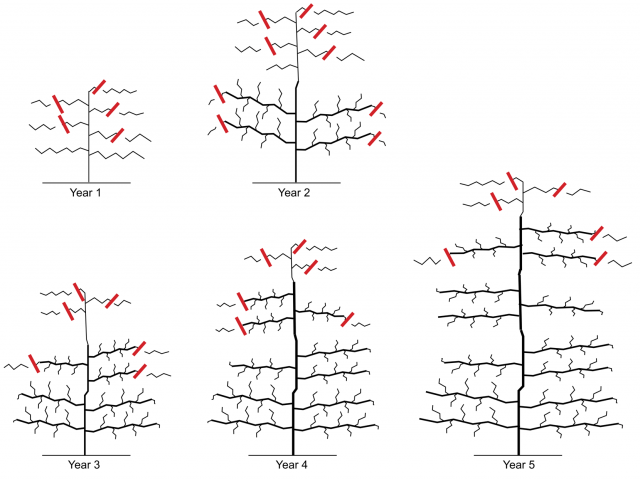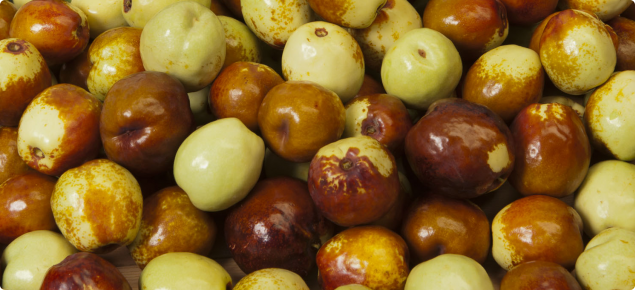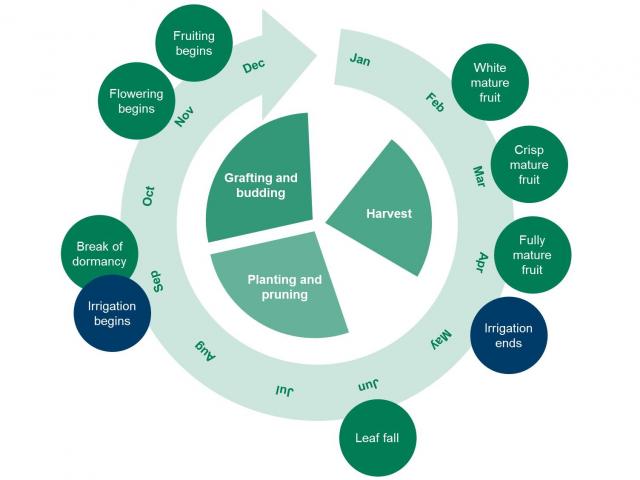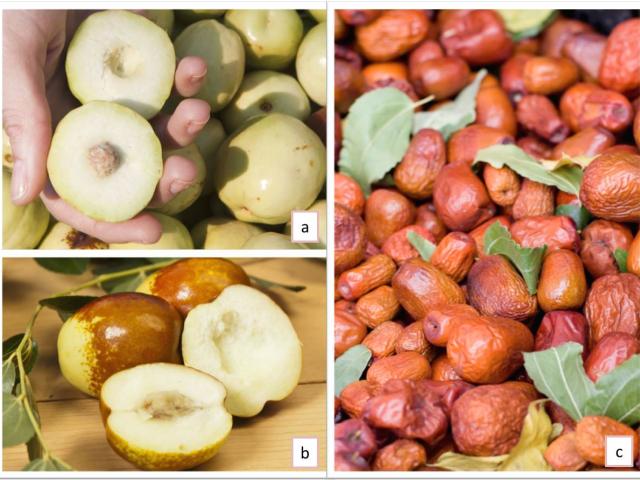The Chinese jujube
The Chinese jujube (Ziziphus jujuba Mill.) is one of the most important fruit crops in China and has been commonly used as a traditional Chinese medicine and food for thousands of years. The jujube is widely grown in China with cultivation records going back more than 3000 years and can also be found in neighbouring countries.
The jujube is a medium-sized tree, growing 7–10 metres high. The tree has shiny deciduous foliage and produces a fruit that is known as a drupe.
The fruit varies in size depending on the cultivar, and it has a thin, dark red skin surrounding a sweet, white flesh. The fruit is very nutritious with potassium, phosphorus, calcium and manganese being the major mineral components, as well as iron, sodium, zinc and copper.
The jujube is a rich source of vitamin C and B-complex. The vitamin C content is higher than other fruits which are well known for high content such as oranges. The antioxidant capacity of fresh jujube is also relatively high compared with other vegetables and fruits.
Jujube fruits are eaten fresh, dried or processed as ‘Chinese dates’ which have been used in confectionery such as breads, cake, candy, compote and jam.
In Western Australia, jujubes are grown in the Perth Hills, the northern Rangelands, the South West and Great Southern regions. Jujubes are also grown in Victoria, South Australia New South Wales, Queensland and the Northern Territory.
Small quantities of jujubes are sold at local markets and some Asian supermarkets in Perth.
Western Australia’s proximity to South East Asia and its counter-seasonal production to the northern hemisphere provides an opportunity to market product for the increasing demand, especially during festivals. Target markets include China, Singapore, Malaysia, Hong Kong and Taiwan.
The jujube industry in Australia has potential to be a new profitable agricultural business to meet the requirements of domestic and overseas markets.
Establishing a jujube orchard
Climate and soils
Jujube trees have a lower water requirement and higher salt tolerance than most fruit crops. Under natural conditions the tree forms a deep and substantial taproot making it drought tolerant. Jujube trees grow best in climates with a long, hot, dry summer after adequate rain early in the season and cool temperatures during its dormancy.
In Western Australia, jujubes are grown in areas with around 200–1000mm annual rainfall.
Studies from China suggest the chilling requirement depends on the cultivar and can range from 775 to 1737 hours at less than 7.2°C. However, areas in WA where jujubes are grown are somewhat lower than this range, yet flowering and fruit set occurs. There is perhaps more to be understood regarding the true chilling requirement for Chinese jujubes under Australian climatic conditions but low to medium chill varieties would be best suited to WA.
Fruit set requires average daily temperatures above 20ºC. Fruit development requires average daily temperatures over 24–25ºC.
Jujubes grow well on a variety of soils. The tree prefers sandy loams or lighter soils but will grow on heavier clays. The jujube tree can tolerate saline, alkaline or slightly acidic soils but grows best in soil with pH 4.5–8.4.
| Condition | Value |
|---|---|
| Annual average temperature (ºC) | 5.5–22 |
| Average temperature of flower season (ºC) | ≥22–24 |
| Minimum temperature (ºC) | ≥ minus 38.2 |
| Frost-free period (days) | ≥100 |
| Annual rainfall (mm) | 87–2000 |
| Annual sunshine (hours) | ≥1100 |
| Soil depth (cm) | ≥30 |
| Soil pH | 4.5–8.4 |
| Soil NaCl (%) | ≤0.15 |
| Soil Na2CO3 (%) | ≤0.3 |
| Soil Na2SO4 (%) | ≤0.5 |
Salt tolerance
Jujubes are known for their salt tolerance but this varies between cultivars. In Western Australia trees have grown successfully using irrigation water with an electrical conductivity of 320mS/m (1800ppm).
Varieties
There are close to 1000 jujube cultivars recorded in China and the number will increase continuously as new cultivars are developed and local traditional cultivars identified.
There is enormous variation among cultivars which can be classified into five groups based on the use of the fruit: fresh; dried; candied; multipurpose and ornamental.
In WA around 15 recognised varieties are grown including Li, Chico, Don Polenski, GA866, Suimen, Thornless, Lang, Silverhill, Sherwood, Shanxi-Li, Redlands, Admiral Wilkes and Si-Hong. The varieties Chico and Li are most favoured fruit in the current local market.
Orchard set up
Conventional jujube orchards are planted at spacings of 4–5m x 5–6m. In China, intensive orchards are planted at 2–3m x 3–4m, 1m x 2m in planned intensive planting, 0.5–0.7m x 1m in super-intensive plantings and protected plantings in greenhouses. In WA the number of trees planted per hectare ranges from around 550 to 1000.
Prior to planting, pits of 0.6–1m cubed are dug at appropriate distances depending on orchard density. The pits are filled with original soil mixed with manure, superphosphate and trace elements. Transplanting trees in the field is most successful just prior to bud burst.
Jujube trees can be damaged by winds so windbreaks are advised if the site is susceptible to strong prevailing winds. Netting is recommended to protect jujube orchards from birds, rabbits and kangaroos.
Economic analysis estimates that establishment costs for a one hectare netted jujube orchard with drip irrigation (including pump, main and sub lines and installation) is over $110 000. Most of the development costs are for trellising and netting and the cost of plants. In the current market it is estimated that it would take eight years until cash flow becomes positive. For more information see the attached document 'Jujube development budget and market analysis'.
Managing a jujube orchard
Soil management
Jujubes grow well on a variety of soils. The tree prefers sandy loam or lighter soil but will grow on well drained clays. Trees can tolerate saline, alkaline or slightly acidic soils. While they can grow in a range of soils, improvement of acidic, alkaline, salty and sandy soils will improve growth and production.
Nutrient management
The key times for nutrition are:
- before budburst (September)
- early flowering (October/November)
- rapid growth stage of young fruit (December)
- immediately after fruit harvest (April/May).
Jujube orchards in WA will need a balanced nutrient program supplying nitrogen (N), phosphorus (P), potassium (K), magnesium (Mg) and trace elements at rates depending on soil fertility, tree age and cropping levels. With deciduous orchards the best time to apply the main annual dressing of NPK is in early spring.
There is little information available for the rates of fertiliser applied to jujubes. Growers can be guided by fertiliser programs for other deciduous orchard species grown in WA. See Jujube fertiler recommendations for more information.
Irrigation
Although jujube trees can survive with very little water, irrigation is an important factor to produce a good yield of quality jujubes. Irrigation scheduling has a direct impact on tree health and fruit yield, size and quality. Without correct scheduling an orchard is more susceptible to nutrient deficiencies, physiological disorders, pests and diseases.
Soil characteristics will influence the type and timing of your irrigation program. Moisture will drain towards the root zone and plant utilisation and water use efficiency will depend on how long it is held there.
Micro sprinklers are a good option for tree crops such as jujubes. Compared to larger sprinklers they are efficient, saving water by only watering the ground under the trees and not the inter-rows. They work on lower pressure and are cheap to run. Trickle and drip irrigation are efficient, economical systems that are well suited to jujubes.
The trees require approximately 3–8 megalitres per hectare (ML/ha) over the growing season, depending on site specific soil and climate.
Scheduling irrigation
Scheduling depends on either measuring soil moisture in the root zone with a moisture meter, or measuring daily evaporation rates. The measurement is combined with a ‘crop factor’, which is a measure of the crop's water harvesting characteristics. It is affected by the root structure and the size of the soil volume from which the roots can extract water. Current water use varies between growers and regions from 3-8ML/ha.
See Jujube irrigation recommendations for more information.
Training and pruning
Training is carried out during the first three to five years of growth (Figure 1). The common forms for conventional orchards are central leader, open center or modified leader systems, and for intensive planting systems, Y type, dwarf pyramid, pillar, espalier, and spindle have been tested with success in China.
Pruning methods are determined by patterns of fruiting. Pruning can be done in both the dormant and growing seasons. Dormant pruning is done mainly to remove shoots that are incapable of producing fruit of suitable size and quality such as weak, diseased, pest-damaged and crowded shoots.
Summer pruning includes removing useless or crowded sprouted buds and new shoots and damaged and diseased shoots. Summer pruning has been shown to be very effective on young and adult trees.
The tree can be trained to a certain shape with or without a central leader by training permanent branches. In general, about six to eight primary branches are kept within a height of 3 to 5 metres and well spaced in all directions. Trees need to be pruned annually to enable the tree to bear a full crop.
In the first season after planting a grafted tree carry out first training pruning during the dormant season:
- Cut the dominant central leader shoot at about 50cm.
- Cut the next three top side shoots back to 1 to 2 buds long.
- Bend down horizontally any side shoots that are too upright.
- Cut other side shoots back to five or six buds. Only cut to length, never trim any of the lateral shoots coming off the side shoot.
Repeat this pruning strategy each year until the tree is about 3m high. Side shoots need to be monitored during the growing season and pulled down to horizontal if growing too upright. Side shoots that get too long need to be trimmed back as soon as possible to the preferred length. To slow upward growth, the top central leader should be cut at the preferred height during the growing season while the shoot is thin.
If the central leader stem gets too thick before cutting, it will likely reshoot with a new vigorous shoot. When side shoots (fruiting arms) get too thick and old, they will start to develop new strong shoots near to the main central leader, when this occurs it is a sign that the fruiting arm needs replacing. Cut the old fruiting arm back close to the main central leader, but at a point where a suitable new horizontal shoot has grown, this new shoot will become the replacement fruiting arm.

Propagation
Until recently Chinese jujube was propagated primarily by root suckers in China. More farmers in China now graft or bud onto seedling rootstocks.
Tissue culture has successfully been used for propagation but commercial production by this technique is still under development due to the requirements on high skill and expensive facilities.
In WA trees are mainly propagated by budding or grafting. For more information see the page Propagating jujubes.
Pests and diseases
Brown spot of jujube, caused by the fungal pathogen Nothophoma quercina was recently detected in WA. No other significant diseases have been found in jujubes to date.
Pests include rabbits, kangaroos and birds but these can be controlled by fencing or netting the orchard. The jujube is susceptible to Mediterranean fruit fly (Medfly) so a baiting program may be required. Three main control strategies are recommended:
- cover spraying
- bait or spot spraying
- lure and kill devices.
The effectiveness of these control techniques should be monitored with traps. Medfly not only affects crop production, but limits access to interstate and overseas markets.
In China some 86 pests and 10 diseases have been reported to be harmful to jujubes. Of the pests, peach fruit moth and Lygus pratensis are most common and serious. Among diseases and disorders, witches broom, fruit splitting and rust are the most serious.
Fruit splitting is an issue for jujubes in Western Australia. It is a water-related physiological disorder and can ruin a large percentage of the crop in some years. The severity depends on water management throughout the growing season, rain around fruit maturation, and cultivar resistance. Maintaining soil moisture during the growing season will help reduce splitting but resistant varieties are the best option.
Bird control
Parrots are the most damaging pest to small and/or relatively isolated orchards. The rainbow lorikeet has also become a serious pest in some growing areas where it can pose an even greater threat to crops than the twenty-eight and red cap parrots.
Bird control methods include:
- Exclusion netting: Although expensive (approximately $30 000/ha) this method will also alleviate the effects of extreme weather events such as hail storms and hot temperatures (sunburn). When assessing the advantage of netting as a means of bird control, the percentage of crop loss as well as the time spent controlling birds by other methods must be taken into account.
- Bird scaring devices: Birds generally become accustomed to scaring devices and noise generators in the orchard and their effectiveness is quickly lost. Varying degrees of control can be obtained by swapping from one device to another and altering their location in the orchard.
- Culling: Unless many hours are spent each week keeping pressure on birds by shooting, they will continuously invade the orchard and ruin a large percentage of your crop.
Contact your local Department of Biodiversity, Conservation and Attractions - Parks and Wildlife Service office prior to scaring, or culling birds on your property as permits may be required for some species.
Without netting, bird control is time consuming and requires a constant commitment to prevent crop damage.
Flowering
Jujube trees bloom in early summer and fruit ripens in late summer/autumn but flowering time can vary at different locations and depends on cultivar and climate. Flowering of jujubes generally occurs over an eight week period in summer. The trees flower from November to December, with fruit starting to ripen at the end of February.
Flowers occur in the axils of the leaves on the current bearing shoots. Flowers are short stemmed, light green-yellow and 3–10mm in diameter. Flower buds complete differentiation and development to mature fruit within a single growing season.
While most cultivars are self-fertile, pollination can be enhanced through the introduction of bees. Pollen is sticky so wind pollination is ineffective. Pollen viability is low in most cultivars. Jujube trees typically have abundant flowering but low fruit set. Heavy fruit drop occurs after fruit set, caused by lack of fertilisation or degeneration of the ovule. Soil moisture stress, low relative humidity, lack of sunlight and strong winds during fruit maturity can also lead to fruit drop.
Measures to improve fruit set include:
- trunk girdling during flowering
- heading back current year shoots
- keeping bees in the orchard during the flower season
- two to three sprays of 10–20ppm gibberellic acid or 0.2% borate during flowering.
Fruit development
The time for fruit maturation varies among cultivars from 60 to 145 days. Fruit development is slightly longer in warmer climates and shorter in cooler climates.
Handling jujubes
Harvesting
Fruit matures from February to April in Western Australia. Immature fruits have green skin and will not ripen if picked. Fruit picked later will continue to ripen after harvest. The fruit can be left on the tree to be picked when dried. At full production, a tree can produce 30–40kg of fresh fruit with an estimated yield of 20–30 tonnes per hectare.
Fruit maturation of Chinese jujube can be divided into three phases:
- White mature: The fruit is near full size and shape; the skin of the fruit is thin and changes from green to greenish white colour.
- Crisp mature: The fruit is half to fully red; the skin becomes thicker, harder and easily separated from the flesh which becomes crisp, juicy and sweet and contains more sugar and acid.
- Fully mature: Sugar content of the flesh increases rapidly and water content begins to decrease. The flesh near the stone and fruit stalk becomes yellow and soft. The skin changes to a dark red and fruit becomes wrinkled.
The proper harvesting time depends on the end use of the fruit (fresh consumption, dried or processed). For fresh consumption jujubes should be picked at the crisp mature stage to prolong storage life. Fruits to be dried should be picked when fully mature and fruits for candying should be picked at the white mature stage.
In China, fruit for fresh consumption is usually hand-picked. Fruit that is dried can be left on the tree until it drops or harvested by shaking the tree or branches.
Postharvest treatment
After harvesting, fruits should be graded according to the degree of ripening and fruit size, then stored under low temperature, dried, or processed. Dehydrated jujube fruits can be obtained by drying under the sun for about three weeks or in a cabinet drier at 60°C for 36–48 hours until the moisture content reduced to less than 25%. The dried fruit can be consumed as such or further processed into juice, wine, powder and so on. For more information see Jujube quality management
Fruit quality testing
Two internal maturity parameters should be tested: total soluble solids and citric acid content (used to calculate sugar-acid ratio). Sugar levels are a commonly used measurement in a wide range of crops. The percentage sugar, measured in degrees Brix (°Brix), indicates the sweetness of the fruit by measuring the number of soluble solids in the juice.
A hand-held refractometer can be used to measure total soluble solids (percentage sugar/°Brix). Acid content of juice from jujube fruits can be measured using a pH meter. The sugar-acid ratio contributes to the unique flavour of the fruit and can be calculated by dividing the degrees Brix by the citric acid concentration.
Tests on fruit grown in Western Australia found that the variety Li had the highest level of total soluble solids (31°Brix) of the three varieties tested and Chico had the lowest (25°Brix). Chico had around double the amount of acid as Li and Suimen and therefore the lowest sugar-acid ratio of the three varieties.
Storage practices
Pests and diseases
Jujube fruit is very perishable and highly susceptible to postharvest decay. Blue mould caused by Penicillin expansum is one of the most serious postharvest diseases of jujube in China.
Storage and processing
Fresh jujube fruit cannot be stored for a long period under ambient conditions due to its perishable nature. Its shelf life is usually only two to three days without any treatment. Studies have shown that semi-red fresh fruits can be kept crisp for over 100 days if packed in 0.04–0.07mm vented polyethylene bags and stored at -1 to 1°C, with relative humidity and CO2 concentration kept within 90–95% and 5% respectively. Dried fruit can be stored for up to 12 months in a dry, cool and sheltered environment.
Storage is not an issue in WA yet as demand is greater than supply so the fruit does not get stored for long. However, as the industry grows and fruit is exported either interstate or overseas then the development of storage techniques and transportation will be a priority.
Markets
Small quantities of Chinese jujube are grown in WA and sold at local markets and some Asian supermarkets in Perth. There is an opportunity to market the fruit both internationally and into the local market as a fresh or dried product.
In 2017, fresh jujubes were sold in Perth at wholesale prices from $8–20 per kilogram. Local dried product sells at retail prices ranging from $25–45 per kilogram.
Western Australia’s proximity to South East Asia and its counter-seasonal production to the northern hemisphere provide an opportunity to market product for the increasing demand, especially during festivals. Target markets include China, Singapore, Malaysia, Hong Kong and Taiwan.
The jujube industry in Australia has the potential to be a new profitable agricultural business to meet the requirements of domestic and overseas markets. The development of a jujube industry will be beneficial in fighting salinity and water shortages which are challenges facing sustainable agriculture in Australia.
West Australian Jujube Growers Association Inc.
The West Australian Jujube Growers Association Inc. was formed in December 2013. It is the representative industry body of jujube growers, formed to strengthen and grow the industry in Western Australia. Its aim is to work with industry and government bodies to implement consistency in all aspects of jujube production and marketing. For more information or to become a member email wajujubegrowersassociation@gmail.com.
Acknowledgements
This work was funded by AgriFutures Australia (formerly Rural Industries Research and Development Corporation) and DPIRD with support from the Western Australian Jujube Growers’ Association.
References
Liu, M. 2003 ‘Genetic diversity of Chinese jujube (Ziziphus jujuba Mill.)’ Acta Hort. (ISHS) 623: pp 351–355.
Liu, M. 2006 ‘Chinese Jujube: Botany and Horticulture’ Horticultural Review, Volume 32 (ed J. Janick), John Wiley & Sons, Inc., Oxford, UK.
Li, J.W., Fan, L.P., Ding, S.D., Ding, X.L., 2007. 'Nutritional composition of five cultivars of Chinese jujube'. Food Chemistry 103, 454–460.
Yan, G and Ferguson, AR 1993 ‘The Chinese Date or Chinese Jujube’ Horticulture in New Zealand, vol 4 number 2, pp 13–18.
Yao, S. 2013 ‘Past, Present and Future Jujubes-Chinese Dates in the United States’, Hort Science, American Society for Horticultural Sciences.







